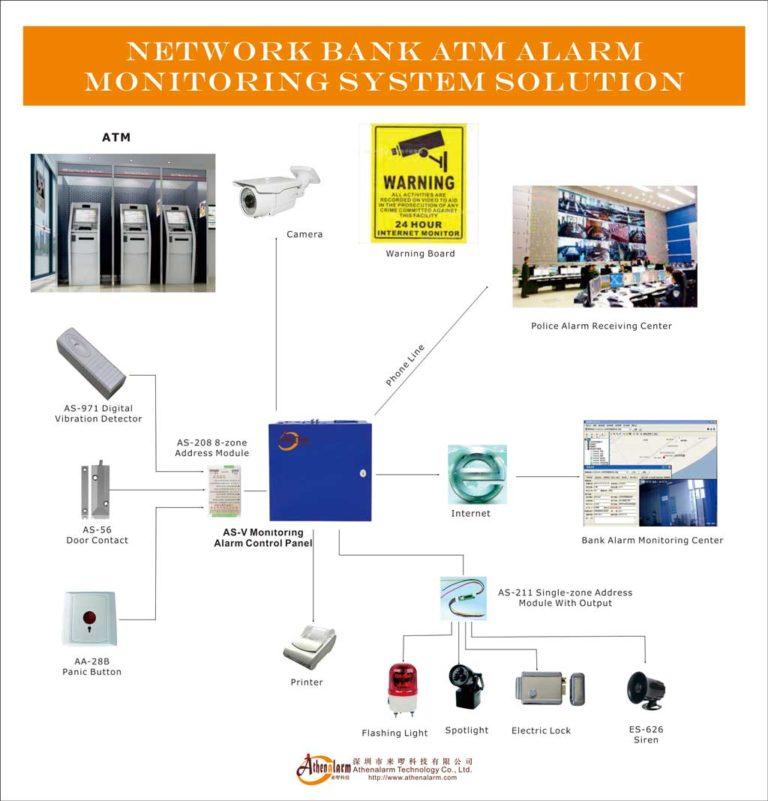



Comprehensive Measures to Enhance Bank ATM Security Systems

1. Introduction
As banks continue expanding ATM deployments in diverse locations, including urban centers, rural areas, and remote regions, security risks have increased. ATMs operate 24/7, often unattended, making them prime targets for criminal activities. While video surveillance is a common security measure, its primary function is post-incident investigation rather than real-time crime prevention. Therefore, strengthening ATM security systems is essential to protect both banks and customers.
Criminals exploit ATMs for various illicit activities, leading to a rise in disputes between banks and customers. Common security threats include:
- Physical vandalism, such as smashing, cutting, or forcibly removing ATMs.
- Unauthorized access to ATM cash vaults using advanced lock-picking techniques.
- Illegal transactions, including unauthorized withdrawals, deposits, and fund transfers.
- Fraudulent activities involving stolen, cloned, or counterfeit bank cards.
- Manipulation of cash dispensing mechanisms to exploit ATM vulnerabilities.
- Customer disputes over cash dispensing errors or failed transactions.
2. Objectives of an ATM Security System
To mitigate these risks, an effective ATM security system should:
- Deter and prevent criminal activities targeting ATMs.
- Provide real-time alerts and minimize losses caused by vandalism or tampering.
- Enable efficient remote monitoring and management of ATMs.
- Record high-quality video and transactional data to assist in fraud detection and dispute resolution.
- Supply comprehensive forensic data for post-incident investigations.
3. 13 Measures to Enhance ATM Security
To achieve these objectives, banks should implement the following security measures:
(1) Deploy Voice Warning Systems and Security Signage
- Install automated voice warning systems at ATM sites to deter potential criminals.
- Display clear security notices inside ATM rooms to enhance user awareness and discourage fraud.
(2) Implement Advanced Video Surveillance
- Use a combination of visible and hidden cameras to discourage tampering and record evidence.
- Position cameras to capture withdrawal transactions and card interactions to counter fraud.
- Ensure long-term video data storage, with alarm-triggered footage securely archived.
(3) Utilize AI-Powered Video Monitoring
- Enable smart surveillance with AI-driven motion detection to identify suspicious activity.
- Implement real-time panoramic monitoring of ATM surroundings to detect potential threats.
(4) Install Intrusion Detection Systems
- Deploy vibration and displacement sensors to detect tampering, drilling, or forced entry attempts.
- Install smoke and heat detectors to address fire hazards.
(5) Enable Automatic Alarm Activation and Response
- Equip ATMs with sirens, strobe lights, and automatic electronic locks to respond to security breaches.
- Ensure instant transmission of alarm signals to a centralized monitoring center for rapid intervention.
(6) Integrate ATM Security Software
- Link intrusion alarm systems with video surveillance for a synchronized security response.
- Implement alarm-triggered video pop-ups at monitoring centers for real-time threat assessment.
(7) Secure Digital Transmission of Security Data
- Utilize encrypted, multi-network transmission for both video and alarm data.
- Implement redundant communication channels to ensure system reliability.
(8) Enable Remote Monitoring and Control
- Equip ATMs with remote access capabilities for centralized security management.
- Implement automated system health checks to promptly detect security failures.
(9) Establish Centralized Alarm Monitoring Centers
- Consolidate ATM security monitoring under a centralized control system.
- Optimize response coordination across multiple ATM locations to enhance efficiency and cost-effectiveness.
(10) Deploy Two-Way Voice Intercom Systems
- Install intercom devices at ATMs to enable direct communication between customers and security personnel.
- Allow security teams to issue real-time verbal warnings to deter suspicious activities.
(11) Implement ATM Protection Cabins
- Construct secure ATM enclosures to provide a private, controlled environment for transactions.
- Utilize access-controlled cabins that allow entry only when unoccupied to prevent unauthorized access.
(12) Strengthen ATM Cash-Handling Security
- Secure cash-loading rooms with door contact sensors to detect unauthorized entry.
- Install vibration detectors on surrounding walls to identify forced access attempts.
- Deploy multiple infrared sensors to detect unauthorized human presence in cash-handling areas.
- Install smoke and heat detectors to prevent fire hazards in cash-loading zones.
(13) Use AI-Powered Fraud Detection Systems
- Integrate machine learning algorithms to analyze transaction patterns and detect anomalies.
- Implement biometric authentication (e.g., fingerprint or facial recognition) to enhance user verification.
4. Conclusion
A robust ATM security system requires a multi-layered approach, combining physical deterrents, intelligent monitoring, and AI-driven fraud detection. By implementing these measures, banks can significantly reduce security risks, enhance operational efficiency, and provide a safer ATM experience for customers.
For expert guidance on ATM security solutions, consult industry best practices and regulatory compliance guidelines.
